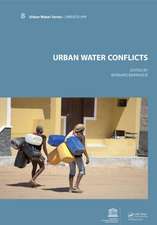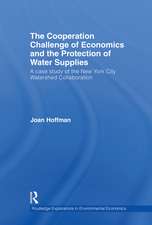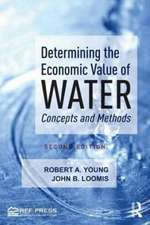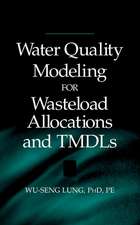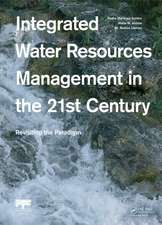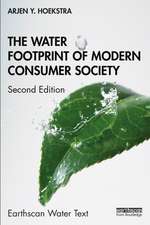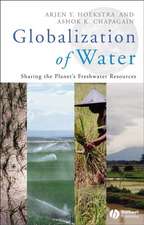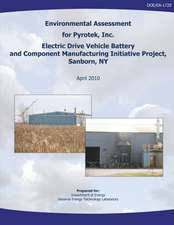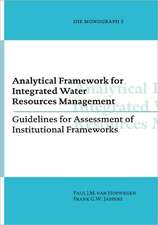The Water Footprint Assessment Manual: Setting the Global Standard
Autor Arjen Hoekstra, Ashok K. Chapagain, Maite M. Aldaya, Mesfin M. Mekonnenen Limba Engleză Paperback – 14 oct 2024
This book offers a complete and up-to-date overview of the global standard on water footprint assessment as developed by the Water Footprint Network. More specifically it:
- provides a comprehensive set of methods for water footprint assessment
- shows how water footprints can be calculated for individual processes and products, as well as for consumers, nations and businesses
- contains detailed worked examples of how to calculate green, blue and grey water footprints
- describes how to assess the sustainability of the aggregated water footprint within a river basin or the water footprint of a specific product
- includes an extensive library of possible measures that can contribute to water footprint reduction.
| Toate formatele și edițiile | Preț | Express |
|---|---|---|
| Paperback (1) | 215.19 lei 6-8 săpt. | |
| Taylor & Francis – 14 oct 2024 | 215.19 lei 6-8 săpt. | |
| Hardback (1) | 765.77 lei 6-8 săpt. | |
| Taylor & Francis – 28 feb 2011 | 765.77 lei 6-8 săpt. |
Preț: 215.19 lei
Preț vechi: 258.21 lei
-17% Nou
Puncte Express: 323
Preț estimativ în valută:
41.18€ • 43.05$ • 34.80£
41.18€ • 43.05$ • 34.80£
Carte tipărită la comandă
Livrare economică 06-20 martie
Preluare comenzi: 021 569.72.76
Specificații
ISBN-13: 9781032927763
ISBN-10: 1032927763
Pagini: 224
Dimensiuni: 156 x 234 mm
Greutate: 0.41 kg
Ediția:1
Editura: Taylor & Francis
Colecția Routledge
Locul publicării:Oxford, United Kingdom
ISBN-10: 1032927763
Pagini: 224
Dimensiuni: 156 x 234 mm
Greutate: 0.41 kg
Ediția:1
Editura: Taylor & Francis
Colecția Routledge
Locul publicării:Oxford, United Kingdom
Public țintă
Academic and Professional Practice & DevelopmentCuprins
Acknowledgements
Preface
1. Introduction
1.1. Background
1.2. The water footprint concept
1.3. Water footprint assessment
1.4. Guide for the reader
2. Goals and scope of water footprint assessment
2.1. Goals of water footprint assessment
2.2. Scope of water footprint accounting
2.3. Scope of water footprint sustainability assessment
2.4. Scope of water footprint response formulation
3. Water footprint accounting
3.1. Human appropriation of fresh water: what do we measure and why?
3.2. Coherence between different sorts of water footprint accounts
3.3. Water footprint of a process step
3.3.1. Blue water footprint
3.3.2. Green water footprint
3.3.3. Grey water footprint
3.3.4. Calculation of the green, blue and grey water footprint of growing a crop or tree
3.4. Water footprint of a product
3.4.1. Definition
3.4.2. Schematisation of the production system into process steps
3.4.3. Calculation of a product water footprint
3.5. Water footprint of a consumer or group of consumers
3.5.1. Definition
3.5.2. Calculation
3.6. Water footprint within a geographically delineated area
3.6.1. Definition
3.6.2. Calculation
3.7. National water footprint accounting
3.7.1. The national water footprint accounting scheme
3.7.2. Calculation of the water footprint within a nation
3.7.3. Calculation of the water footprint of national consumption
3.7.4. Water savings related to trade
3.7.5. National water dependency versus water self-sufficiency
3.8. Water footprint accounting for catchments and river basins
3.9. Water footprint accounting for municipalities, provinces or other administrative units
3.10. Water footprint of a business
3.10.1. Definition
3.10.2. Choosing the organisational boundaries of the business
3.10.3. Calculation of the business water footprint
4. Water footprint sustainability assessment
4.1. Introduction
4.2. Geographic sustainability: sustainability of the water footprint within a catchment or river basin
4.2.1. Introduction
4.2.2. Environmental sustainability criteria for identifying environmental hotspots
4.2.3. Social sustainability criteria for identifying social hotspots
4.2.4. Economic sustainability criteria for identifying economic hotspots
4.2.5. Assessing primary and secondary impacts in the hotspots identified
4.3. Sustainability of the water footprint of a process
4.4. Sustainability of the water footprint of a product
4.4.1. Identifying the unsustainable components in the water footprint of a product
4.4.2. Water footprint impact indices reflecting local environmental impacts
4.5. Sustainability of the water footprint of a business
4.6. Sustainability of the water footprint of a consumer
5. Library of water footprint response options
5.1. Shared responsibility
5.2. Reducing the water footprint of humanity: what is possible?
5.3. Consumers
5.4. Companies
5.5. Farmers
5.6. Investors
5.7. Governments
6. Limitations
7. Future challenges
7.1. Water footprint assessment methodology and data
7.2. Application of the water footprint in different contexts
7.3. Embedding the water footprint in existing water and environmental accounts and reports
7.4. Linking to ecological, energy and carbon footprint methods
7.5. Linking to material flow analysis, input-output modelling, a
Preface
1. Introduction
1.1. Background
1.2. The water footprint concept
1.3. Water footprint assessment
1.4. Guide for the reader
2. Goals and scope of water footprint assessment
2.1. Goals of water footprint assessment
2.2. Scope of water footprint accounting
2.3. Scope of water footprint sustainability assessment
2.4. Scope of water footprint response formulation
3. Water footprint accounting
3.1. Human appropriation of fresh water: what do we measure and why?
3.2. Coherence between different sorts of water footprint accounts
3.3. Water footprint of a process step
3.3.1. Blue water footprint
3.3.2. Green water footprint
3.3.3. Grey water footprint
3.3.4. Calculation of the green, blue and grey water footprint of growing a crop or tree
3.4. Water footprint of a product
3.4.1. Definition
3.4.2. Schematisation of the production system into process steps
3.4.3. Calculation of a product water footprint
3.5. Water footprint of a consumer or group of consumers
3.5.1. Definition
3.5.2. Calculation
3.6. Water footprint within a geographically delineated area
3.6.1. Definition
3.6.2. Calculation
3.7. National water footprint accounting
3.7.1. The national water footprint accounting scheme
3.7.2. Calculation of the water footprint within a nation
3.7.3. Calculation of the water footprint of national consumption
3.7.4. Water savings related to trade
3.7.5. National water dependency versus water self-sufficiency
3.8. Water footprint accounting for catchments and river basins
3.9. Water footprint accounting for municipalities, provinces or other administrative units
3.10. Water footprint of a business
3.10.1. Definition
3.10.2. Choosing the organisational boundaries of the business
3.10.3. Calculation of the business water footprint
4. Water footprint sustainability assessment
4.1. Introduction
4.2. Geographic sustainability: sustainability of the water footprint within a catchment or river basin
4.2.1. Introduction
4.2.2. Environmental sustainability criteria for identifying environmental hotspots
4.2.3. Social sustainability criteria for identifying social hotspots
4.2.4. Economic sustainability criteria for identifying economic hotspots
4.2.5. Assessing primary and secondary impacts in the hotspots identified
4.3. Sustainability of the water footprint of a process
4.4. Sustainability of the water footprint of a product
4.4.1. Identifying the unsustainable components in the water footprint of a product
4.4.2. Water footprint impact indices reflecting local environmental impacts
4.5. Sustainability of the water footprint of a business
4.6. Sustainability of the water footprint of a consumer
5. Library of water footprint response options
5.1. Shared responsibility
5.2. Reducing the water footprint of humanity: what is possible?
5.3. Consumers
5.4. Companies
5.5. Farmers
5.6. Investors
5.7. Governments
6. Limitations
7. Future challenges
7.1. Water footprint assessment methodology and data
7.2. Application of the water footprint in different contexts
7.3. Embedding the water footprint in existing water and environmental accounts and reports
7.4. Linking to ecological, energy and carbon footprint methods
7.5. Linking to material flow analysis, input-output modelling, a
Notă biografică
Arjen Y. Hoekstra is Professor in Water Management at the University of Twente, the Netherlands; creator of the water footprint concept and Scientific Director of the Water Footprint NetworkAshok K. Chapagain was an irrigation engineer in Nepal for more than a decade, worked as a researcher at the University of Twente, and currently works for the WWF in the UKMaite M. Aldaya works as a consultant for the United Nations Environment Programme (UNEP) and is a researcher at the Water Footprint NetworkMesfin M. Mekonnen was an energy expert at the Ministry of Mines and Energy in Ethiopia, and is currently a PhD student at the University of Twente
Recenzii
'Water is vital to business: poor water quality or insufficient supply can curtail - or even shut down - activities in business operations and in the supply chain. The method laid out in The Water Footprint Assessment Manual fills an emerging and urgent business need for a means of understanding water consumption in operations and in the supply chain, assessing its sustainability, and devising effective response strategies.' – Monika Weber-Fahr, Global Business Line Leader for IFC's Sustainable Business Advisory
'Forty years down the road we will have 9 billion humans living on the Earth. Nearly fifty per cent more than what we have today. The impact of any activity, be it economic or social, will have an unprecedented print on water. It is, therefore, critical that policy makers and the public, let alone the political community, are aware of what the water footprint is, how it is established and how it does evolve in time and space. This book is a must for all those who wish to understand why and how water became the single most important commodity humanity has. But most importantly, it also provides methodologies of comparing the footprint of our various actions in order to strive towards sustainable water use.' – Professor A. Szollosi-Nagy, Rector, UNESCO-IHE Institute for Water Education
'The Global Water Footprint Standard comes at a time when companies in all sectors are awakening to the risk that water scarcity poses to their bottom lines and reputations. This work helps companies understand their dependency and impact on water resources, and offers guidance on response strategies that conserve water for industry, communities and nature.' – Jim Leape, Director General of WWF International.
'Clean, fresh water is increasingly scarce world-wide for people and nature. It is therefore essential that businesses or citizens that want to act responsibly understand their water use and its impacts. The standardized methods developed by the Water Footprint Network to analyze and compare water uses are important in this respect. WWF applauds the publication of this guidance through which a valuable tool becomes available for everyone.' – Johan van de Gronden, CEO WWF-Netherlands
'We at DEG, member of KfW Bankengruppe, value water as one of the most important natural resources. We actively engage to finance entrepreneurial initiatives in the water sector aimed at creating a sustainable use of water. Congratulations to the second edition of The Water Footprint Assessment Manual, which can help our clients to understand better their water risks and opportunities in a globalizing economy.' – Dr. Peter Thimme, Director Sustainable Development, Environment, First Vice President, DEG
'A decade ago, the architects of the water footprint concept captured the world's interest by unveiling the volumes of water required to produce the goods we consume in our daily lives. Those water footprint numbers made us aware that personal and corporate responsibility for water use extends well beyond the walls of our homes or our factories -- it extends throughout the supply chains, particularly the farm fields, where water is consumed in delivering goods and ingredients to us. Now, with the publication of The Water Footprint Assessment Manual, we have come to appreciate the fact that true water stewardship is not solely about the volume of our water footprints - instead, it's about paying attention to where those footprints land, in local watersheds, and paying attention to the undesirable impacts that come with unsustainable water use. This Manual will be invaluable to anyone wishing to assess, and improve, the sustainability of their water use.' – Brian Richter, Managing Director of Global Freshwater Program, The Nature Conservancy
'Population growth and economic development is placing enormous pressure on our already scarce fresh water supplies. We produce water thirsty commodities in dry locations, we over allocate water resources within watersheds, and we continue to overwhelm our natural systems with pollution, placing more than 126,000 freshwater dependent species, as well as human beings, at great risk. The Water Footprint Assessment Manual is an extremely valuable tool and standard methodology that we hope will be widely adopted by governments, non-profits, corporations, and watershed managers to ensure the sustainability of producing various goods and services in various locations and to accurately report water use and management information across product supply chains and in watersheds.' – Russ Mittermeier, President, Conservation International
'Forty years down the road we will have 9 billion humans living on the Earth. Nearly fifty per cent more than what we have today. The impact of any activity, be it economic or social, will have an unprecedented print on water. It is, therefore, critical that policy makers and the public, let alone the political community, are aware of what the water footprint is, how it is established and how it does evolve in time and space. This book is a must for all those who wish to understand why and how water became the single most important commodity humanity has. But most importantly, it also provides methodologies of comparing the footprint of our various actions in order to strive towards sustainable water use.' – Professor A. Szollosi-Nagy, Rector, UNESCO-IHE Institute for Water Education
'The Global Water Footprint Standard comes at a time when companies in all sectors are awakening to the risk that water scarcity poses to their bottom lines and reputations. This work helps companies understand their dependency and impact on water resources, and offers guidance on response strategies that conserve water for industry, communities and nature.' – Jim Leape, Director General of WWF International.
'Clean, fresh water is increasingly scarce world-wide for people and nature. It is therefore essential that businesses or citizens that want to act responsibly understand their water use and its impacts. The standardized methods developed by the Water Footprint Network to analyze and compare water uses are important in this respect. WWF applauds the publication of this guidance through which a valuable tool becomes available for everyone.' – Johan van de Gronden, CEO WWF-Netherlands
'We at DEG, member of KfW Bankengruppe, value water as one of the most important natural resources. We actively engage to finance entrepreneurial initiatives in the water sector aimed at creating a sustainable use of water. Congratulations to the second edition of The Water Footprint Assessment Manual, which can help our clients to understand better their water risks and opportunities in a globalizing economy.' – Dr. Peter Thimme, Director Sustainable Development, Environment, First Vice President, DEG
'A decade ago, the architects of the water footprint concept captured the world's interest by unveiling the volumes of water required to produce the goods we consume in our daily lives. Those water footprint numbers made us aware that personal and corporate responsibility for water use extends well beyond the walls of our homes or our factories -- it extends throughout the supply chains, particularly the farm fields, where water is consumed in delivering goods and ingredients to us. Now, with the publication of The Water Footprint Assessment Manual, we have come to appreciate the fact that true water stewardship is not solely about the volume of our water footprints - instead, it's about paying attention to where those footprints land, in local watersheds, and paying attention to the undesirable impacts that come with unsustainable water use. This Manual will be invaluable to anyone wishing to assess, and improve, the sustainability of their water use.' – Brian Richter, Managing Director of Global Freshwater Program, The Nature Conservancy
'Population growth and economic development is placing enormous pressure on our already scarce fresh water supplies. We produce water thirsty commodities in dry locations, we over allocate water resources within watersheds, and we continue to overwhelm our natural systems with pollution, placing more than 126,000 freshwater dependent species, as well as human beings, at great risk. The Water Footprint Assessment Manual is an extremely valuable tool and standard methodology that we hope will be widely adopted by governments, non-profits, corporations, and watershed managers to ensure the sustainability of producing various goods and services in various locations and to accurately report water use and management information across product supply chains and in watersheds.' – Russ Mittermeier, President, Conservation International


